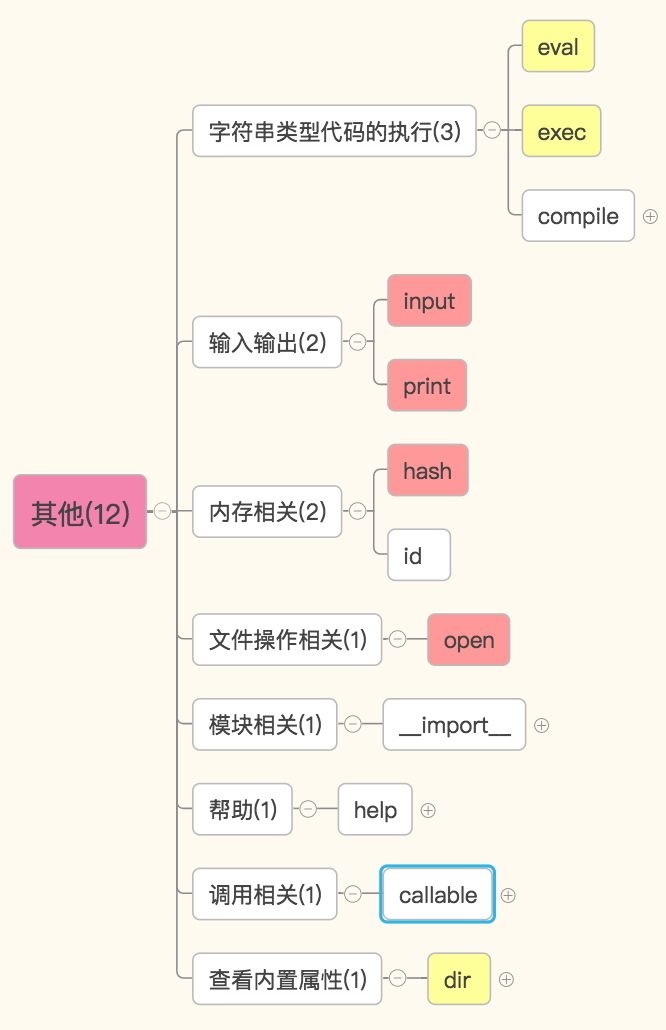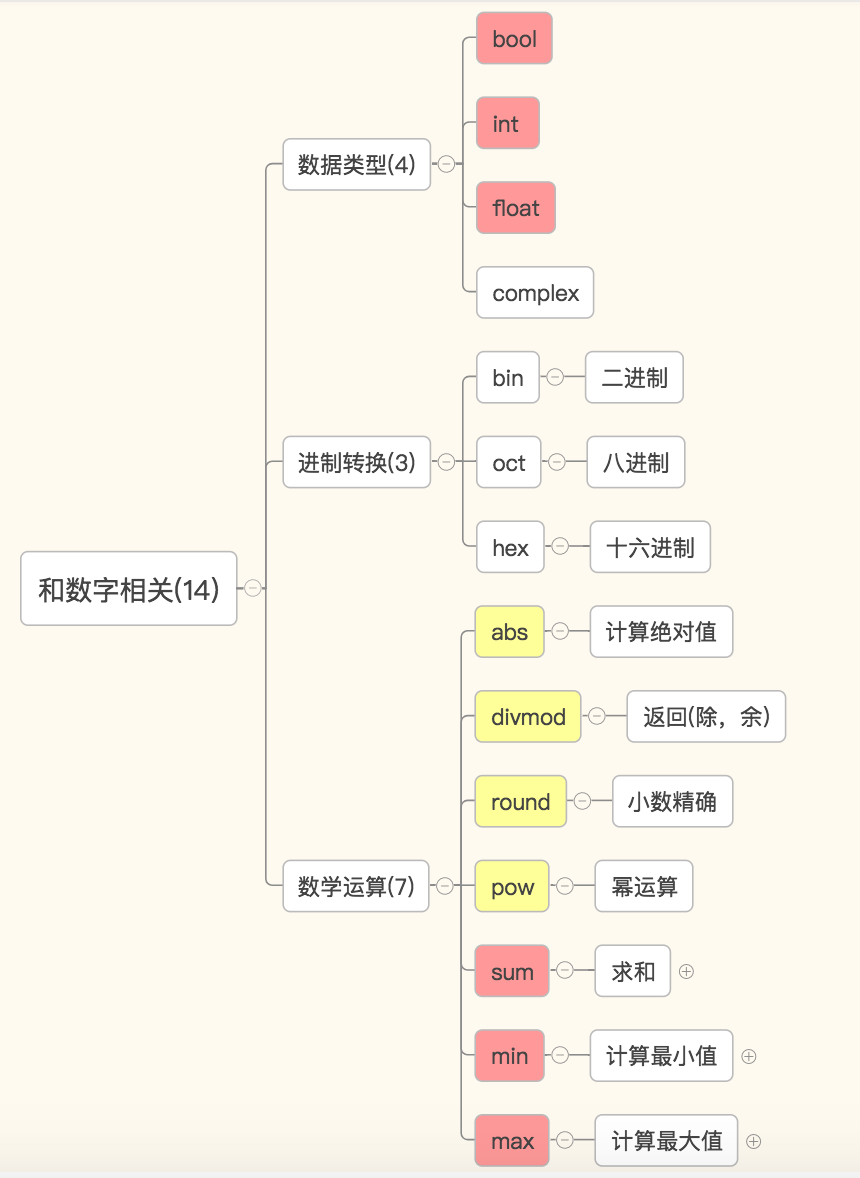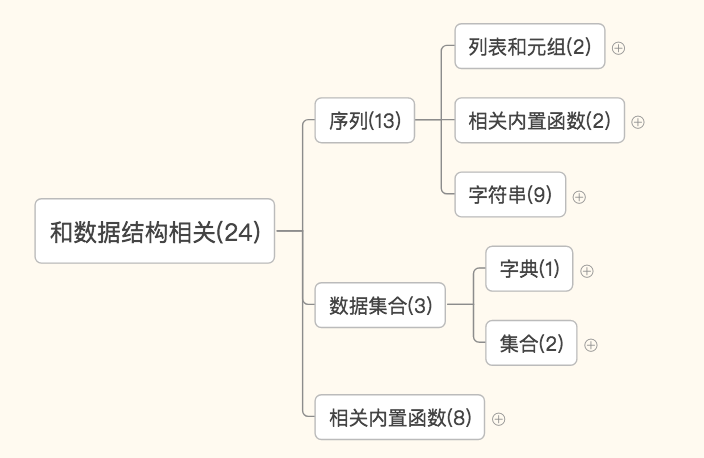内置函数
内置函数
python里的内置函数。截止到python版本3.6.2,现在python一共为我们提供了68个内置函数。
这个表的顺序是按照首字母的排列顺序来的

作用域相关

基于字典的形式获取局部变量和全局变量
globals()——获取全局变量的字典
locals()——获取执行本方法所在命名空间内的局部变量的字典
其他

字符串类型代码的执行
内置函数——eval、exec、compile
eval() 将字符串类型的代码执行并返回结果
print(eval('1+2+3+4'))
exec()将自字符串类型的代码执行
print(exec("1+2+3+4"))
exec("print('hello,world')")

code = '''
import os
print(os.path.abspath('.'))
'''
code = '''
print(123)
a = 20
print(a)
'''
a = 10
exec(code,{'print':print},)
print(a)
#指定global参数
code = '''
import os
print(os.path.abspath('.'))
'''
code = '''
print(123)
a = 20
print(a)
'''
a = 10
exec(code,{'print':print},)
print(a)
compile 将字符串类型的代码编译。代码对象能够通过exec语句来执行或者eval()进行求值。
参数说明:
1. 参数source:字符串或者AST(Abstract Syntax Trees)对象。即需要动态执行的代码段。
2. 参数 filename:代码文件名称,如果不是从文件读取代码则传递一些可辨认的值。当传入了source参数时,filename参数传入空字符即可。
3. 参数model:指定编译代码的种类,可以指定为 ‘exec’,’eval’,’single’。当source中包含流程语句时,model应指定为‘exec’;当source中只包含一个简单的求值表达式,model应指定为‘eval’;当source中包含了交互式命令语句,model应指定为'single'。
>>> #流程语句使用exec >>> code1 = 'for i in range(0,10): print (i)' >>> compile1 = compile(code1,'','exec') >>> exec (compile1) 3 7 >>> #简单求值表达式用eval >>> code2 = '1 + 2 + 3 + 4' >>> compile2 = compile(code2,'','eval') >>> eval(compile2) >>> #交互语句用single >>> code3 = 'name = input("please input your name:")' >>> compile3 = compile(code3,'','single') >>> name #执行前name变量不存在 Traceback (most recent call last): File "<pyshell#29>", line 1, in <module> name NameError: name 'name' is not defined >>> exec(compile3) #执行时显示交互命令,提示输入 please input your name:'pythoner' >>> name #执行后name变量有值 "'pythoner'"
输入输出相关:
input() 输入
s = input("请输入内容 : ") #输入的内容赋值给s变量 print(s) #输入什么打印什么。数据类型是str
print() 输出
def print(self, *args, sep=' ', end='\n', file=None): # known special case of print """ print(value, ..., sep=' ', end='\n', file=sys.stdout, flush=False) file: 默认是输出到屏幕,如果设置为文件句柄,输出到文件 sep: 打印多个值之间的分隔符,默认为空格 end: 每一次打印的结尾,默认为换行符 flush: 立即把内容输出到流文件,不作缓存 """
f = open('tmp_file','w') print(123,456,sep=',',file = f,flush=True)
import time for i in range(0,101,2): time.sleep(0.1) char_num = i//2 #打印多少个'*' per_str = '\r%s%% : %s\n' % (i, '*' * char_num) if i == 100 else '\r%s%% : %s'%(i,'*'*char_num) print(per_str,end='', flush=True) #小越越 : \r 可以把光标移动到行首但不换行
数据类型相关:
type(o) 返回变量o的数据类型
内存相关:
id(o) o是参数,返回一个变量的内存地址
hash(o) o是参数,返回一个可hash变量的哈希值,不可hash的变量被hash之后会报错。
t = (1,2,3) l = [1,2,3] print(hash(t)) #可hash print(hash(l)) #会报错 ''' 结果: TypeError: unhashable type: 'list' '''
hash函数会根据一个内部的算法对当前可hash变量进行处理,返回一个int数字。
*每一次执行程序,内容相同的变量hash值在这一次执行过程中不会发生改变。
文件操作相关
open() 打开一个文件,返回一个文件操作符(文件句柄)
操作文件的模式有r,w,a,r+,w+,a+ 共6种,每一种方式都可以用二进制的形式操作(rb,wb,ab,rb+,wb+,ab+)
可以用encoding指定编码.
模块操作相关
__import__导入一个模块
import time os = __import__('os') print(os.path.abspath('.'))
帮助方法
在控制台执行help()进入帮助模式。可以随意输入变量或者变量的类型。输入q退出
或者直接执行help(o),o是参数,查看和变量o有关的操作。。。
和调用相关
callable(o),o是参数,看这个变量是不是可调用。
如果o是一个函数名,就会返回True
def func():pass print(callable(func)) #参数是函数名,可调用,返回True print(callable(123)) #参数是数字,不可调用,返回False
查看参数所属类型的所有内置方法
dir() 默认查看全局空间内的属性,也接受一个参数,查看这个参数内的方法或变量
print(dir(list)) #查看列表的内置方法 print(dir(int)) #查看整数的内置方法
和数字相关

数字——数据类型相关:bool,int,float,complex
数字——进制转换相关:bin,oct,hex
数字——数学运算:abs,divmod,min,max,sum,round,pow
和数据结构相关

序列——列表和元组相关的:list和tuple
序列——字符串相关的:str,format,bytes,bytearry,memoryview,ord,chr,ascii,repr
ret = bytearray('alex',encoding='utf-8') print(id(ret)) print(ret[0]) ret[0] = 65 print(ret) print(id(ret))
ret = memoryview(bytes('你好',encoding='utf-8')) print(len(ret)) print(bytes(ret[:3]).decode('utf-8')) print(bytes(ret[3:]).decode('utf-8'))
序列:reversed,slice
l = (1,2,23,213,5612,342,43) print(l) print(list(reversed(l)))
l = (1,2,23,213,5612,342,43) sli = slice(1,5,2) print(l[sli])
数据集合——字典和集合:dict,set,frozenset
数据集合:len,sorted,enumerate,all,any,zip,filter,map




 浙公网安备 33010602011771号
浙公网安备 33010602011771号